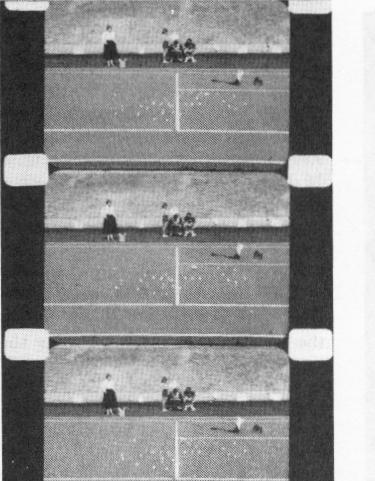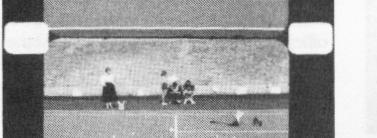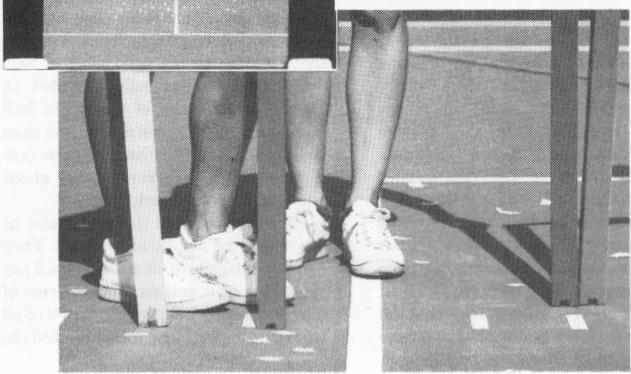| Previous | Index |
point of impact by an average of five inches, had seven miscalls in 63 attempts, for an error rate of 11 per cent, and were unable even to call the ball on ten other occasions because they could not see it. This was especially true on the 100-mile-an-hour serves. Acknowledges tennis coach Will Arias, "I had a feel for whether it was in or out, but I couldn't tell how far. A lot of times it was just, 'Lord, help me get it back.' "
Braden's conclusion that linesmen make the most accurate calls throws doubt on the wisdom of the rule-insti
tuted just three years ago-that allows the chair umpire to reverse a linesman. Ken Farrar, one of five full-time supervisors on the Grand Prix (men's professional) tour, defends the regulation as necessary to keep order. "It's only for obvious mistakes," he says. "We tell umpires it's ludicrous to overrule a ball that's closer than two inches to the line." But Braden points out that the average error of umpires in his studies was greater than two inches. Says he, "There should be no overrules unless the linesman asks for help."
T he tennis world first got word of Braden's unsettling findings when he gave a short talk and showed a 20-minute video tape to officials at the U.S. Open in New York City this fall. The linesmen cheered, but some chair umpires were skeptical. "If a man can't see a ball two inches from the line," says Jason Smith, an official at the Open every year since 1959, "he should not be in the tennis business, he should be selling seeing-eye dogs." The critics complained that some of Braden's "linesmen" and "umpires" were not experienced referees, but only coaches from his Tennis College. Nonetheless, Bob Rockwell, chairman of the USTA Umpires Committee, says that the number of overrules at the tournament, already down from last year, declined even further after the Braden session.
Rockwell wants Braden to help tennis officials by making a training film based on his recent tests and showing ways to improve accuracy. One way, Braden thinks, would be for the lines
Film sequence shows this serve hitting
a foot inside the line, but player (yellow stick) and near-side linesman (green) said it was out; far-side linesman (blue) and umpire (orange) called it in
man calling the baseline to watch the flight of the ball long enough to determine about where it will cross the line, then fix his gaze there until the ball hits. This would reduce head movement that could distort the eyeballs.
Braden concedes that his experiments need more data and better controls, but he thinks the results are good enough to show that human error is a significant factor in officiating in tennis-and probably most other sports, too. "The implications are fantastic," he says. "In basketball, the referee is running back and forth the whole game, having the same problem seeing as the players. How about hockey, when the referees are skating at full speed?"
The answer, Braden says, is more and better referee training. But others, including his partner, Gideon Ariel, think that the Coto de Caza studies point up the need for automated equipment, like the electronic serve caller used at Wimbledon and at the U.S. Open since 1980. This instrument, known informally as the Cyclops, projects infrared light beams along and just outside the service line. A ball that breaks the outside beams without breaking the beam along the line is ruled out. But Cyclops is no good for baselines or sidelines, because the player may interrupt the beam with his foot. Inventors have tried to solve this problem with alternative systems that use exposed wires on the tennis court, magnets in the ball, even a special chemical coating that leaves a disappearing mark on the court. None of these has won the same acceptance from tennis officials as the Cyclops.
Although Rockwell thinks that the Cyclops, or some variation of it, will eventually replace the service linesman, many players fear the intrusion of machines. Says Jim McManus, of the Association of Tennis Professionals, the players' union, "We might as well get robots out there to play, and put mechanical clappers in the stands." And veteran umpire Frank Hammond, who had the singular distinction of tossing Ilie Nastase out of the 1979 U.S. Open only to be ousted himself by the tournament referee, feels that unerringly accurate and unchallengeable electronic line callers might just do the game of tennis in. "If everybody just smiled and hit balls back and forth," he says, "it would be a rather boring sport."
DISCOVER December 1982



| Previous | Index |